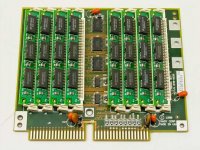As an interesting parlor trick, I was able to to allocate 8MB of expanded memory as extended memory using Quarterdeck's EMS2EXT.SYS driver, and afterward leveraged QEXT.SYS to manage that as XMS. Granted, it's not actually
usable as such, but it did fake out at least one program that had previously refused to start otherwise.
What's really a shame is that the DRAM controller used in the TX and TL systems supports an additional megabyte of memory in the 100000-1FFFFF range. This capability went unused, but appears to have at least been partially implemented with the TX motherboard...
This is mostly conjectural, but per the technical reference manual, it looks like 128K of extended memory can be had in the TX by:
- Installing four 64K x 4 DRAM chips in the unpopulated/unmarked positions beside U54, U55, U56, and U57.
- Installing a jumper at E7-E8, thereby selecting "Memory Configuration 4," which is defined as follows:
| BANK0 | BANK1 | BANK2 | CONTROL | ADDRESS RANGE |
| 512K | | | Ras0 | 000000-07FFFF |
| 128K | | Ras1 | 080000-09FFFF |
| | 128K | Ras2 | 100000-11FFFF |
- Enabling the A20 gate, using the aforementioned port 68h control (through a modified handler).
BAM!

